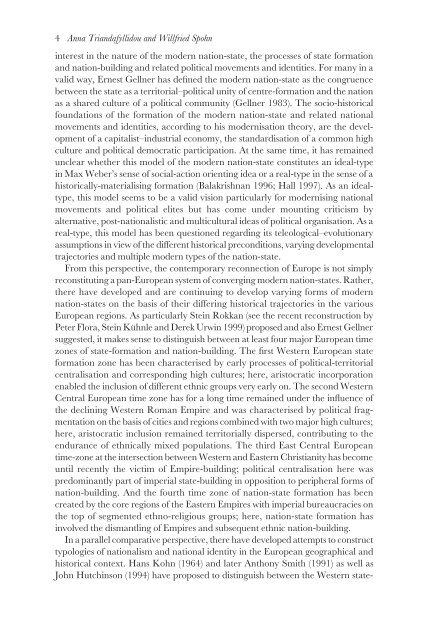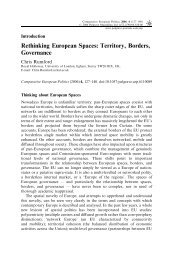Europeanisation, National Identities and Migration ... - europeanization
Europeanisation, National Identities and Migration ... - europeanization
Europeanisation, National Identities and Migration ... - europeanization
Create successful ePaper yourself
Turn your PDF publications into a flip-book with our unique Google optimized e-Paper software.
4 Anna Tri<strong>and</strong>afyllidou <strong>and</strong> Willfried Spohn<br />
interest in the nature of the modern nation-state, the processes of state formation<br />
<strong>and</strong> nation-building <strong>and</strong> related political movements <strong>and</strong> identities. For many in a<br />
valid way, Ernest Gellner has defined the modern nation-state as the congruence<br />
between the state as a territorial–political unity of centre-formation <strong>and</strong> the nation<br />
as a shared culture of a political community (Gellner 1983). The socio-historical<br />
foundations of the formation of the modern nation-state <strong>and</strong> related national<br />
movements <strong>and</strong> identities, according to his modernisation theory, are the development<br />
of a capitalist–industrial economy, the st<strong>and</strong>ardisation of a common high<br />
culture <strong>and</strong> political democratic participation. At the same time, it has remained<br />
unclear whether this model of the modern nation-state constitutes an ideal-type<br />
in Max Weber’s sense of social-action orienting idea or a real-type in the sense of a<br />
historically-materialising formation (Balakrishnan 1996; Hall 1997). As an idealtype,<br />
this model seems to be a valid vision particularly for modernising national<br />
movements <strong>and</strong> political elites but has come under mounting criticism by<br />
alternative, post-nationalistic <strong>and</strong> multicultural ideas of political organisation. As a<br />
real-type, this model has been questioned regarding its teleological–evolutionary<br />
assumptions in view of the different historical preconditions, varying developmental<br />
trajectories <strong>and</strong> multiple modern types of the nation-state.<br />
From this perspective, the contemporary reconnection of Europe is not simply<br />
reconstituting a pan-European system of converging modern nation-states. Rather,<br />
there have developed <strong>and</strong> are continuing to develop varying forms of modern<br />
nation-states on the basis of their differing historical trajectories in the various<br />
European regions. As particularly Stein Rokkan (see the recent reconstruction by<br />
Peter Flora, Stein Kühnle <strong>and</strong> Derek Urwin 1999) proposed <strong>and</strong> also Ernest Gellner<br />
suggested, it makes sense to distinguish between at least four major European time<br />
zones of state-formation <strong>and</strong> nation-building. The first Western European state<br />
formation zone has been characterised by early processes of political-territorial<br />
centralisation <strong>and</strong> corresponding high cultures; here, aristocratic incorporation<br />
enabled the inclusion of different ethnic groups very early on. The second Western<br />
Central European time zone has for a long time remained under the influence of<br />
the declining Western Roman Empire <strong>and</strong> was characterised by political fragmentation<br />
on the basis of cities <strong>and</strong> regions combined with two major high cultures;<br />
here, aristocratic inclusion remained territorially dispersed, contributing to the<br />
endurance of ethnically mixed populations. The third East Central European<br />
time-zone at the intersection between Western <strong>and</strong> Eastern Christianity has become<br />
until recently the victim of Empire-building; political centralisation here was<br />
predominantly part of imperial state-building in opposition to peripheral forms of<br />
nation-building. And the fourth time zone of nation-state formation has been<br />
created by the core regions of the Eastern Empires with imperial bureaucracies on<br />
the top of segmented ethno-religious groups; here, nation-state formation has<br />
involved the dismantling of Empires <strong>and</strong> subsequent ethnic nation-building.<br />
In a parallel comparative perspective, there have developed attempts to construct<br />
typologies of nationalism <strong>and</strong> national identity in the European geographical <strong>and</strong><br />
historical context. Hans Kohn (1964) <strong>and</strong> later Anthony Smith (1991) as well as<br />
John Hutchinson (1994) have proposed to distinguish between the Western state-



